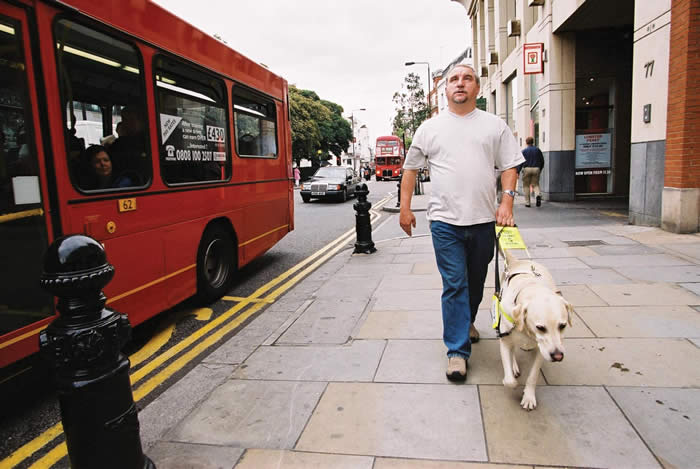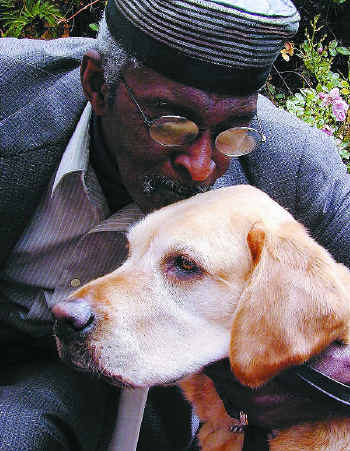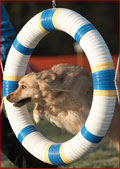How Guide Dogs Work
For most dog owners, the expression "work like a dog" doesn't make much sense. While the typical canine companion certainly gives his owner immeasurable happiness, it's obvious that he lives a life of remarkable leisure. Our pets gracefully go from the carefree days of childhood directly to the rest and relaxation of retirement, skipping the working part of life entirely.
But some dogs happily perform very demanding jobs for much of their life, putting in a full day's work just like the rest of us. Guide dogs, one of the most familiar sorts of working dog, provide an invaluable service to humans. Every day, they help their masters get from place to place more safely.
In this post, we'll find out what the life of a guide dog is all about: We'll see what their job is like, how they are trained and what happens to them when they retire. We'll also learn what we can all do to help guide dogs do their job correctly, and find out about some ways interested people can get involved with raising guide dogs.
What Guide Dogs Do
Guide dogs help blind or visually impaired people get around in the world. In most countries, they are allowed anywhere that the public is allowed, so they can help their handlers be any place they might want to go. To do this, a guide dog must know how to:
- Keep on a direct route, ignoring distractions such as smells, other animals and people
- Maintain a steady pace, to the left and just ahead of the handler
- Stop at all curbs until told to proceed
- Turn left and right, move forward and stop on command
- Recognize and avoid obstacles that the handler won't be able to fit through (narrow passages and low overheads)
- Stop at the bottom and top of stairs until told to proceed
- Bring the handler to elevator buttons
- Lie quietly when the handler is sitting down
- Help the handler to board and move around buses, subways and other forms of public transportation
- Obey a number of verbal commands
Additionally, a guide dog must know to disobey any command that would put the handler in danger. This  ability, called selective disobedience, is perhaps the most amazing thing about guide dogs -- that they can balance obedience with their own assessment of the situation.
ability, called selective disobedience, is perhaps the most amazing thing about guide dogs -- that they can balance obedience with their own assessment of the situation.
This capacity is extremely important at crosswalks, where the handler and dog must work very closely together to navigate the situation safely. When the team reaches the curb, the dog stops, signaling to the handler that they have reached a crosswalk. Dogs cannot distinguish the color of traffic lights, so the handler must make the decision of when it is safe to proceed across the road. The handler listens to the flow of traffic to figure out when the light has changed and then gives the command "forward." If there is no danger, the dog proceeds across the road in a straight line. If there are cars approaching, the dog waits until the danger is gone and then follows the forward command.
In a handler-guide dog team, the guide dog doesn't lead the handler and the handler doesn't completely control the guide dog; the two work together to get from place to place. The guide dog doesn't know where the destination is, so it must follow the handler's instructions of how far to go and when to turn. The handler can't see the obstacles along the way, so the guide dog must make its own decisions as to how to navigate the team's path. Each half of the team relies on the other to accomplish the tasks at hand.
As a guide dog gets more experience with its handler, it may be able to take on even more responsibility. For example, many veteran guide dogs know all of their master's usual destinations. All the handler has to tell them is "go to the office" or "find the coffee shop," and the guide dog will follow the complete route!
Guide dogs enjoy their work immensely, and they get a lot of satisfaction from a job well done, but there is no room for typical dog fun during the work day. Games, treats and praise distract the dog from helping its handler navigate the course. Even when the handler doesn't need assistance, a guide dog on the job is trained to ignore distractions and keep still. This is because a guide dog must be able to come to the handler's workplace or be in public places without creating a disturbance.
When you see a guide dog on the job, it is extremely important that you recognize that it is at work. Petting or talking to the dog breaks its concentration, which impairs the handler's ability to get around in his or her surroundings. People are very impressed with guide dogs and so we have a natural inclination to praise them, but the best thing you can do to help a guide dog is to leave it alone so that it can pay attention to its surroundings and maintain its focus on its handler. Guiding is very complicated, and it requires a dog's undivided attention.
On the Job and After Hours
When a guide dog gets home at the end of the day, however, it will play and soak up praise just like an ordinary pet. Guide dogs make the distinction between work and play based on their lead harness: When the harness is on, they must stay completely focused -- when it comes off, it's play time. Guide dogs work very hard every day, but they lead extremely happy lives, full of lots of attention and stimulation. Dogs only end up working as guide dogs if they absolutely love the work. In fact, many handlers report that their dogs leap enthusiastically into the harness every morning!
Where Guide Dogs Come From
Guide dogs come out of guide dog schools. Typically, these institutions provide guide dogs for seeing-impaired people at no cost. Most schools are completely non-profit operations, primarily funded by charitable donations. Some training schools specialize in certain aspects of training, but many of them organize just about everything involved in setting up a guide dog with a handler. This includes:
- Breeding guide dogs
- Arranging puppy raising programs for future guide dogs
- Evaluating prospective guide dogs
- Training guide dogs
- Training instructors
- Training handlers
- Matching handlers with suitable dogs
- Re-evaluating and retiring guide dogs
- Placing retired dogs in new homes
Most guide dog schools use golden retrievers, Labrador retrievers or German shepherds. These three breeds are characterized by intelligence, obedience, stamina and friendliness and so are well suited for the job. 
Guide dog schools breed their dogs very carefully, choosing parents with intelligence and special guiding ability.
Even with this attention to good breeding, many puppies don't turn out to be suited for the job. At Guiding Eyes for the Blind, a respected guide dog school based in Yorktown Heights, New York, trainers screen young puppies for guiding aptitude, and release 20 percent of them from the program. Some of these puppies go on to organizations that train other sorts of service dogs -- dogs that help people in wheelchairs, for example -- and the rest are sold as pets (with an agreement that the dog will be spayed or neutered, in order to help control the pet population).
The other 80 percent of the puppies stay on the path to becoming guide dogs. As we'll see in the following sections, the training is intense, the emotional level is high and everybody works very hard. The results are truly amazing: Guide dogs completely change their handlers' lives!
Puppy Raisers
When they're ready to leave their mother, dogs that show a level of aptitude for guiding go to a loving home to enjoy being a puppy and grow into a well-trained young adult.
These volunteer puppy raisers are just ordinary people who go through an application process and training  program at the guide dog school. The school screens for raising ability and works with puppy raisers one-on-one to help them learn how to work with the puppy. In addition, the school will generally provide the raisers with a manual and video that tells them almost everything they need to know. The raiser's job is to teach the puppy obedience skills, expose the puppy to all sorts of people and environments and give the puppy all the love and attention it needs to grow into a happy, confident dog that is ready for guide training. Basically, raisers lay the groundwork for the more extensive guide training to come.
program at the guide dog school. The school screens for raising ability and works with puppy raisers one-on-one to help them learn how to work with the puppy. In addition, the school will generally provide the raisers with a manual and video that tells them almost everything they need to know. The raiser's job is to teach the puppy obedience skills, expose the puppy to all sorts of people and environments and give the puppy all the love and attention it needs to grow into a happy, confident dog that is ready for guide training. Basically, raisers lay the groundwork for the more extensive guide training to come.
One of the most important aspects of raising a future guide dog is to get it comfortable with all kinds of situations. Socialization is important for any dog, but it is crucial for guide dogs, who must be able to go anywhere without being distracted from their work. They must be accustomed to loud noises, adverse weather conditions, crowds of people and tricky obstacles. A guide dog needs to be confident in any situation its handler might experience. In Guiding Eyes for the Blind puppy raising programs, raisers typically expose the puppies to at least five new experiences a week.
In order to excel in advanced training later on, the puppy needs to get some experience with obedience early in life. Guiding Eyes for the Blind teaches puppy raisers to first develop a good working relationship with the dog. It is extremely important that future guide dogs are attentive and responsive to their handlers, and that they have the self-confidence to handle complex commands and stressful situations. The most important job of a puppy raiser is fostering these qualities.
Raisers also teach puppies the basics of obedience -- to sit, lie down and walk correctly on a leash -- and get them used to extensive training sessions several times a week. Raisers train the puppy using leash corrections and praise, never treat rewards. It's very important that a future guide dog not be fixated on food because when they're on the job, they will have to work without the expectation of a reward and they will have to maintain concentration in restaurants and other areas with food distractions.
Raising a future guide dog is a wonderful experience, but it is very difficult emotionally. At the end of the puppy raising period, a little over a year, the puppy raiser must bring the dog back to the training school so it can go on to help a blind or visually impaired person. Giving the dog up after raising it for a year is a very sad experience, but puppy raisers are rewarded by the satisfaction of contributing to the process. Most puppy raisers end up raising many future guide dogs, because of the happiness it brings them.
If you're interested in raising a future guide dog, check the links at the end of the article or look in the phone book for a guide dog school in your area. Guiding Eyes for the Blind has a number of puppy training programs set up on the east coast of the United States -- check Guiding Eyes Puppy Raising for a program in your area. Most schools have a comprehensive program that will teach you everything you need to know to start a guide dog off right. If you love dogs and have the time to care for a puppy, you can play a critical part in the guide dog training process.
Training
Once it is grown-up, socialized and well-trained, the dog returns to the guide dog school for evaluation. Guide dog instructors look for a number of qualities, including:
- Intelligence
- Willingness to learn
- Ability to concentrate for extended periods of time
- Attention to touch and sound
- Good memory
- Excellent health
Even if a dog has all these qualities, however, it may be a poor candidate for training. Instructors screen out a lot of intelligent dogs because they have undesirable qualities, such as:
- Aggressive tendencies
- Nervous temperament
- Extreme reaction to cats or other dogs
After the instructor has spent some time with a dog, he or she decides whether the dog is a good candidate for guide dog training, not suited for guide dog training or not quite ready for guide dog training.
In some schools, if a dog is suited for training but not quite ready, it may go back to the puppy raiser for a month or so to mature. If a dog is simply not suited for training, the school will work to place the dog in another line of work, such as tracking, or find it a permanent home, usually offering it to the puppy raiser first. At Guiding Eyes for the Blind, only the top 50 percent of the returning puppies will stay with the school -- so the school places a little over 400 puppies with raisers each year, needing only 200 dogs for the training program. Of that 200, a small percentage will become breeding stock, for Guiding Eyes or another school, and the rest will be considered for the training program.
Training is a rigorous process for both the instructors and the dogs, but it's also a lot of fun. To make sure the dogs are up to the challenge, most schools test them extensively before beginning the training. The tests are designed to assess the dogs' self-confidence level, since only extremely confident dogs will be able to deal with the pressure of guiding instruction. If a dog passes the tests, it begins the training program right away.
Different schools have different programs, but typically, training will last four to five months. To make sure the dogs master all the complex guide skills, the instructors have to introduce them to each idea gradually. Once they have introduced what is expected of the dog, training is essentially a matter of rewarding correct performance and punishing incorrect performance. This works with dogs because they are pack animals and have a natural need to please an authority figure. The instructor, and later the handler, is simply stepping into the place of the alpha dog, the leader of the pack.
Unlike ordinary obedience training, guide dog training does not use food as a reward for good performance. This is because a guide dog must be able to work around food without being distracted by it. Instead, instructors use praise or other reward systems to encourage correct performance. The standard means of correction is pulling on the dog's leash, so that it pulls a training collar, giving the dog a slight pinch. Using this basic reward/punishment system, instructors work through the necessary skills for guiding.
The first step is learning how to walk like a guide dog. This means walking in a straight line, without being distracted by surrounding activity. It also means keeping pace to the left and just ahead of the handler, and responding to leash corrections as well as verbal commands. Dogs learn how to walk correctly by degrees. First, they are simply taught to move directly from point to point. Then, the instructors steadily introduce greater and greater distractions, eventually venturing out into malls and city streets, and correct the dog if it veers off course. The process, which continues throughout the entire training program, is largely a matter of building up the dog's concentration level so that even the most tempting distraction won't lure it off course.
The dogs are also learning to stop at curbs from the very beginning. This is one of the most critical guide dog skills, because the safety of the handler depends on absolute mastery of the concept. Once the dogs have learned to always stop at a curb, they must learn how to judge potential dangers before crossing the street.
Many training schools have simulated street intersections on their campus so they can expose the dogs to a number of traffic situations. The dogs learn how to handle themselves safely around cars, and develop the ability to spot all sorts of potential dangers. This is the part of the training that focuses on selective disobedience. To become a guide dog, each candidate must demonstrate absolute mastery of crosswalk navigation.
One tricky part of training is teaching the dog to navigate obstacles with its handler in mind. Dogs learn fairly quickly to take the wide path around objects in the handler's path, so the handler won't trip over them. Learning how to deal with tight spaces is more difficult, but through reward and correction, the instructor gradually demonstrates to the dog that it should never go through a space that is too narrow or too low for its handler.
Additionally, dogs must learn a number of commands, must always stop for stairs and must practice all of the other necessary skills until they become second nature. This is a lot to learn, and not all dogs succeed in the program. At Guiding Eyes for the Blind, only about 72 percent of dogs that enter the training program make it to graduation.
The dogs that do master all of the skills by the end of the training period go on to the next step in the process: getting to know their handlers.
Forming a Team
The final stage of a guide dog's training is learning to work with its new master. Guide dog training schools work very hard to match handlers with guide dogs according to the compatibility of their personalities. A very energetic dog typically does well with a young handler, while an older handler may need an especially careful partner. Schools often have a special gathering to commemorate the time when a new class of guide dogs finally meet their masters. Often, the dog's puppy raiser attends and meets with the new master as well. This is perhaps the most emotional time in the entire training process.
After this introduction, guide dog instructors typically spend a month helping the new team learn to work together. Many schools have dormitories for the handlers to stay in during this final stage of training.
If the handler has never used a guide dog before, a lot of the instructor's work at this point is actually people-training, not dog-training. The handler has to learn to read the dog's movements, so he or she knows when the dog is turning or when the dog is stopping for a crosswalk or stairs. Additionally, the handler has to learn all the commands the dog knows, and must get some practice walking with the dog. The dog has to make the transition from obeying the instructor to recognizing the handler as its new master. The handler and the dog spend a lot of this time just getting to know each other, so they are comfortable enough to work as a team. By the time they graduate from the guide dog school, they can read each other's every movement.
Guide Dog Instructors
Guide dogs are typically trained by highly qualified instructors who are assisted by a number of apprentice instructors. Procedures vary from school to school, but in general, trainers must spend two to three years as a supervised apprentice before they can move up to a master instructor. Different states have different certification processes for guide dog instruction.
Instructors and apprentice instructors are typically college graduates with a good deal of prior experience dealing with both animals and people. Because most guide dog schools are non-profit institutions, instructor pay is relatively low for the education level required; it is still, however, a very difficult job to get. Openings don't come up all that often, and the competition is usually pretty tight. Often, trainers work their way up to apprentice instructor by working with the school on a lower level, such as raising guide dog puppies.
The job is extremely demanding intellectually, emotionally and physically. Instructors work very hard for long hours, and they must constantly deal not only with difficult animals but also with difficult people. It is definitely rewarding work, though. Instructors say they get a great deal of satisfaction from helping a difficult dog master its job, and they're certainly very happy putting together a functioning dog-and-handler team.
Retirement
Working as a guide dog requires peak physical and mental shape, so guide dogs typically retire just before they enter old age. Older dogs are usually sharp enough to keep working, but they may slow down a little, which hinders their ability to keep up with the brisk pace of their handlers. Retirement is usually at age eight or 10; but some work for a little longer, and some guide dogs retire earlier if they're having trouble with the work. A few dogs from the Guiding Eyes for the Blind program are still working at age 13!
or 10; but some work for a little longer, and some guide dogs retire earlier if they're having trouble with the work. A few dogs from the Guiding Eyes for the Blind program are still working at age 13!
When a guide dog retires, the handler will get a new dog, but he or she may also have the option to keep the retired dog as a pet. If the handler can't keep two dogs, then the guide dog school looks for a new home for the retired dog. The school may track down the original puppy raisers, or it may place the dog in a new loving home. Schools generally have a waiting list of people who want to adopt a retiree. After all, former guide dogs are extremely intelligent and friendly and have perfect manners -- who wouldn't want one? Giving a retired guide dog a loving home is also an excellent way to help reward these amazing animals for a lifetime of hard, important work.
From: HowStuffWorks.com







 Ontario Dog Sports
Ontario Dog Sports
Reader Comments